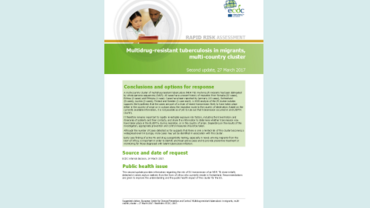Multidrug-resistant tuberculosis in migrants, multi-country cluster, first update 19 Dec 2016
An international cluster involving 16 cases of multidrug-resistant tuberculosis in asylum seekers has been detected. Although the limited number of cases detected so far suggests that there is only a limited risk of this outbreak becoming a widespread event, more cases may occur in association with this cluster.
Executive Summary
A cluster involving seven cases of multidrug-resistant tuberculosis (MDR TB) in asylum seekers has been detected in Switzerland between February and August 2016. Based on whole genome sequencing results, the strains belong to a single cluster. The same genetic information with the same drug resistance profile was detected in nine additional MDR TB cases in Austria, Germany and Sweden.
The seven cases of MDR TB were diagnosed in Switzerland among 15–19 year-olds from Somalia (5), Eritrea (1) and Ethiopia (1). The men had sought asylum at different points in time between December 2015 and June 2016.
One of the patients was diagnosed four months after contact with one of the other cases. So far, no other epidemiological link has been identified. Based on whole genome sequencing (WGS) analysis, the seven strains are genetically highly related and are likely part of a single molecular cluster.
In addition, as of 19 December, Germany reported six cases with the same genetic clone in asylum seekers from Somalia. Two cases of MDR TB with the same resistance profile were detected in Austria. One of which showed the same drug susceptibility pattern as the cases detected in Switzerland; for the second, drug susceptibility testing is currently on-going. The same pattern was identified in Sweden in a patient from Somalia.
Limited risk of further spread
The available information from the cluster in Switzerland suggests a possible recent transmission. It is likely that the patients were infected either in their country of origin or in a place along their migration route to the country of destination. The small number of cases detected so far suggests a limited risk that this outbreak could spread wider. However, more cases may occur in association with this cluster.It will be important to perform epidemiological investigations, including contact tracing, source case investigation, and investigation of possible epidemiological links. Early case finding of active TB and drug susceptibility ensures identification and treatment of active TB cases and allows preventive treatment or monitoring for those diagnosed with latent tuberculosis infection. Although TB in a foreign-born population does not have a significant influence on TB in the native population in the EU/EEA, there is a risk of transmission for both migrants and the native population. ECDC is working with all EU/EEA Member States on identification of cases with an MDR TB strain showing the same genetic pattern.







